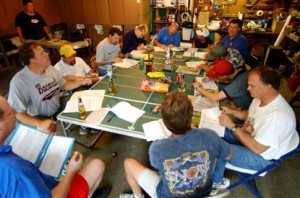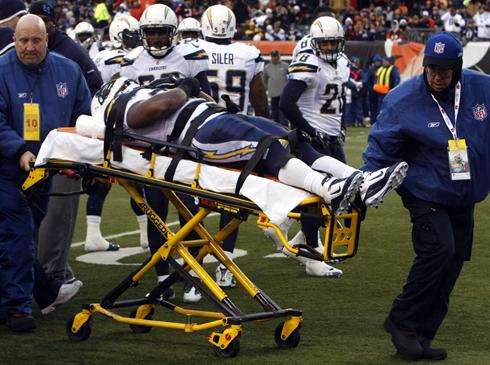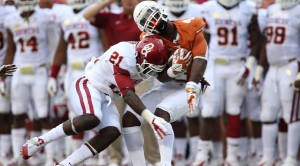Posted on
October 17, 2016 by
Tony Samboras

Sam Bradford was a key addition following the injury to Teddy Bridgewater.
In 2015, the Minnesota Vikings surprised a lot of people, finishing 3rd in the NFC with a record of 11-5. In the process, they upended archrival Green Bay for the NFC North title. Coming into the 2016 season, they were given a reasonable chance of making the playoffs, though no one was really predicting a repeat conference win over the Packers.
The teams chances of making another run for the playoffs took a serious hit early in the pre-season when starting QB Teddy Bridgewater went down with a season-ending injury. This was already an offense that struggle last season, finishing 4th worst in the league with 321 YPG. The fact is receiver corps was young and inexperienced coming into the season didn’t figure to help matters much.
The one person the Vikings knew they could count on was All-Pro RB Adrian Peterson, who led the league in rushing in 2015 with 1,485 yards and 11 TDs. The ability to count on him lasted exactly five quarters as he too would go down with a season ending injury.
With two big blows to its playoff hopes for the season, Head Coach Mike Zimmer was called upon to begin doing damage control. The first thing the team did was go out and trade with the Philadelphia Eagles for veteran QB Sam Bradford. Often injured, Bradford was at least able to bring some starting expense to the table, something the Vikings couldn’t find internally.
Next up was to simplify the offense and try to limits mistakes. The thought was the defense was certainly good enough to keep games close, which could result in a few wins if the offense didn’t shoot itself in the foot. While this notion and winning with Bradford at QB seemed a long shot at best, a 5-0 record speaks volumes about never underestimating good defense in the NFL. Read the rest of this entry →
Tags: Minnesota VikingsSam Bradford
Category
Football, NFL
Posted on
October 08, 2016 by
Dixie Somers

Fenway Park is the oldest stadium used for Major League Baseball today.
Sports stadiums are the modern gladiator arenas. Rabid fans descend upon the booming bowl of seats to watch their favorite athletes perform out on the field. And modern stadiums have great influence over the way we experience the spectacle. Through innovative design, fan interaction concourses and a curated ballpark menu, stadiums have come to be a spectacle unto themselves. And you could learn all about these unique fan experiences with an online athletic administration master’s degree. Get a head start. Here are 5 facts about the most famous stadiums in the world.
1. Fenway Park
Fenway Park is the oldest stadium used in the major leagues. Built in 1912, the park is older than many West Coast states. But many people don’t know the Green Monster wasn’t designed that way. Leftfield used to have a large hill that tapered up to a smaller wall during the dead ball era. It was called Duffy’s cliff, named after the Red Sox leftfielder that roamed the area. When it was removed in 1933, the Green Monster emerged.
2. Roman Colosseum
There are many spectacular facts about planet Earth’s original massive stadium. The side of the Colosseum collapsed during an earthquake in 847, the West exit is known as the Gate of Death for the dead gladiators dragged through it, and the word Colosseum is always capitalized for the famous structure despite the fact that the word translates into “large arena for entertainment.” But the most amazing fact is that the wooden floor of the Colosseum would be removed and the open channels below would be filled with water for mock naval battles. Read the rest of this entry →
Tags: fenway parklambeau field
Category
Baseball, Basketball, Football, Sports History
Posted on
September 27, 2016 by
Jim Smith
 Football season is one of the many harbingers of fall. Whether you bundle up to watch your teen score a goal on the field under the big field lights, join the office pool for fantasy football, or just enjoy the game at home, there are many ways to get the most out of the football season.
Football season is one of the many harbingers of fall. Whether you bundle up to watch your teen score a goal on the field under the big field lights, join the office pool for fantasy football, or just enjoy the game at home, there are many ways to get the most out of the football season.
Volunteer, Coach, or Play
If you used to play football in high school or college, what better way to relive those good ol’ days by coaching football at the grade school, high school, or even collegiate level? Granted, you need to know the game (what football fanatic doesn’t?) and it helps to have a Bachelor’s degree, a teaching license, and coaching experience, but one can dream, right?
If coaching isn’t part of your career path, you can always find away to volunteer, whether you apply to be an assistant coach or sell concessions during halftime. Volunteering at a local football game is a great way to see the game for free because you don’t need to watch a professional team to enjoy the game.
If coaching or volunteering is out, why not gather family and friends together to play a friendly (and competitive) game in the backyard before you sit down and enjoy the game? Read the rest of this entry →
Tags: Fantasy Football
Category
Football
Posted on
September 25, 2016 by
Dean Hybl

Vin Scully has been an icon since announcing his first major league game in 1950.
After more than six decades, legendary Brooklyn and Los Angeles Dodgers announcer Vin Scully is saying goodbye to the broadcast booth. To say that we will never see another Vin Scully may be quite an understatement.
Since he debuted as the third announcer along with Red Barber and Connie Desmond for the Brooklyn Dodgers in 1950, Scully has been baseball’s great storyteller.
Listening to a Vin Scully broadcast is not just an afternoon enjoying live baseball. It is an afternoon remembering both legendary and relatively obscure players from baseball’s past while also likely having American culture and history woven into the conversation.
Scully is not just a walking baseball encyclopedia, he is a walking American history book.
Having grown up in the Washington Heights section of Manhattan, Scully spent two years in the U.S. Navy before attending Fordham University. During his college career, Scully played on the baseball team while writing for the school newspaper and broadcasting football and basketball games on the radio.
Following his graduation, Scully was a fill-in announcer for CBS Radio station WTOP in Washington, DC. It was during this time that Red Barber, the Sports Director for the CBS Radio Network, recruited him to broadcast college football games.
After joining the Dodgers broadcast team in 1950, Scully continued to learn his craft from the legendary Barber. In 1953, Barber got into a salary dispute with World Series broadcast sponsor Gillette, propelling the 25-year-old Scully into the broadcast booth for his first World Series. He still holds the record as the youngest broadcaster to announce a World Series game.
He eventually became the lead announcer for the Dodgers and stayed with the team when they moved to Los Angeles following the 1957 season.
Though he is originally a New Yorker, it was in California where Scully truly became a broadcasting legend. Announcing Dodger games during the era of Sandy Koufax, Don Drysdale and Maury Wills, Scully became a fan favorite as many would bring transistor radios to the stadium just to hear Scully call the action. Read the rest of this entry →
Tags: CBS RadioLos Angeles DodgersNBC TelevisionVin Scully
Category
Baseball, Football, NFL, Sports History, Vintage Video
Posted on
September 19, 2016 by
Kara Masterson
 Football may always be fun to watch, but unfortunately, it is not always pleasant to play. According to research by the United States Safety Commission, football is the third most dangerous sport, so it is no surprise that members of the NFL regularly deal with injuries. Players get hurt basically every day in professional football. The dangers of the game are almost endless, however, these five injuries are the most common reasons for injury in the NFL.
Football may always be fun to watch, but unfortunately, it is not always pleasant to play. According to research by the United States Safety Commission, football is the third most dangerous sport, so it is no surprise that members of the NFL regularly deal with injuries. Players get hurt basically every day in professional football. The dangers of the game are almost endless, however, these five injuries are the most common reasons for injury in the NFL.
Knee Injuries
An analysis of injury data from the NFL shows that knee injuries are the most common football injury by far. This happens because the players are often hit right in the middle of pivoting and making other risky knee movements. Though it is possible to recover from knee injuries, it takes quite a bit of time. In some cases, players cannot continue playing afterwards. Depending on the situation knee injuries can be very serious and even require surgery and physical therapy.
Ankle Injuries
The ankle is also a delicate joint in the leg, and it is therefore the second most likely source of injury. Ankle injuries tend to happen during improper tackles, such as the outlawed “horse collar tackle,” so some players end up needing lawyers, such as those at Ahlander Injury Law, to seek damages after another player hurts their ankle. Injuries like this can also be serious depending on the situation, but if you get it looked at as soon as possible you should be able to have a steady recovery. Read the rest of this entry →
Tags: Football InjuriesNFL
Category
Football, NFL
Posted on
September 15, 2016 by
Matt Rhoney
 Fall will be here soon, and that means football season has come crashing onto the country’s TVs, yards, and stadiums. That’s right, it’s time for the weekly rough and tumble rumble of good ol’ fashioned gridiron. Helmets colliding, pigskins soaring, and bodies bashing. It’s all here.
Fall will be here soon, and that means football season has come crashing onto the country’s TVs, yards, and stadiums. That’s right, it’s time for the weekly rough and tumble rumble of good ol’ fashioned gridiron. Helmets colliding, pigskins soaring, and bodies bashing. It’s all here.
Football casts a powerful spell on players and fans alike. The game’s appeal is so strong, so compelling that enthusiasts of all stripes—be it on the field, sidelines, bleachers, or the couch—regularly forget the risks into which football puts it players. Safety is crucial to football. Players, coaches, family, and even fans all need to keep the safety question alive if football is going to survive as one America’s great games. College football is a field in which safety needs to be top priority.
College Ball, Helmets, and Head Injuries
Let’s kick this off with the big one: head injuries. If football doesn’t deal with this room’s elephant, the game will soon be endangered species. Helmets, brain trauma, and the football industry’s role in these issues have been featured in the New York Times several times a month for a long time now, and there’s been no indication the buzz is dying down.
As it stands, head injuries are a normal part of football. They don’t need to be. For college players and coaches, this issue needs serious attention. According to personal injury attorneys, head injuries are a common result of negligence. College players suffer head injuries regularly, and the research into university football and TBIs is not in nearly as advanced a state as is similar research into the NFL. What is to be done about student heads, and who should be doing it? Read the rest of this entry →
Tags: College FootballHead Injuries
Category
College Football, Football





